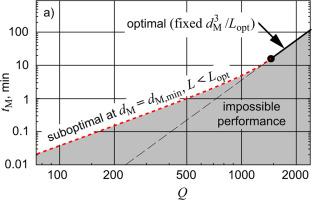Knox-Saleem kinetic performance limits in liquid chromatography—A contemporary tutorial
IF 3.2
引用次数: 0
Abstract
The kinetic performance limits evaluated by Knox and Saleem in 1969 are reevaluated herein. Published 55 years ago, the original study did not address several key features of contemporary chromatography. The following features of chromatographic analyses were assumed in the source:
- •The static operations (isothermal isobaric GC, isocratic isothermal isobaric LC).
- •The columns packed with discrete particles.
- •The columns were optimized to deliver the smallest plate height.
In this tutorial focusing mostly on LC, the original Knox-Saleem study is extended to gradient elution LC, to the columns with arbitrary structure (open, packed, pillar array, monolithic, etc.) and to suboptimal operations – all expressed in contemporary notations. The study is based on previously published basic structure-independent equations of column kinetic performance.
Some conclusions of this tutorial are different from previous ones. It has been concluded herein that at any pressure (no matter how low) any separation performance (no matter how high) can be achieved as long as the analysis time is acceptable. This seems to contradict with Knox-Saleem statement suggesting that there is “the critical pressure below which a separation number S cannot be achieved however much time is available.” Similar statement was also previously known from Giddings (1962): “critical pressure, pc, the inlet pressure below which a [required, LB] separation can never be obtained”.

液相色谱中的诺克斯-萨利姆动力学性能极限--当代教程
本文对 Knox 和 Saleem 于 1969 年评估的动力学性能极限进行了重新评估。最初的研究发表于 55 年前,并未涉及当代色谱法的几个关键特征。资料来源假定色谱分析具有以下特征:-静态操作(等温等压气相色谱、等压等温等压液相色谱)。本教程主要侧重于液相色谱,将 Knox-Saleem 的原始研究扩展到梯度洗脱液相色谱、任意结构的色谱柱(开放式、填料式、柱阵列、整体式等)以及次优操作,所有这些都用现代符号表示。本研究基于之前发布的与结构无关的色谱柱动力学性能基本方程。本文得出的结论是,只要分析时间可以接受,在任何压力下(无论多低)都可以实现任何分离性能(无论多高)。这似乎与诺克斯-萨利姆(Knox-Saleem)的说法相矛盾,他认为 "存在临界压力,在此压力之下,无论有多少时间,都无法达到分离度 S"。Giddings (1962 年)也有类似的说法:"临界压力,pc,入口压力,低于该压力将永远无法获得[所需的,LB]分离"。
本文章由计算机程序翻译,如有差异,请以英文原文为准。
求助全文
约1分钟内获得全文
求助全文
来源期刊

Journal of chromatography open
Analytical Chemistry
CiteScore
2.50
自引率
0.00%
发文量
0
审稿时长
50 days
 求助内容:
求助内容: 应助结果提醒方式:
应助结果提醒方式:


